The Young Professional's Cheat Sheet to Building a Professional Wardrobe
The Young Professional's Cheat Sheet: The guide to everything you need in your closet to begin your career.
So… you’ve graduated college and started your new job wearing the black suit that Mom and Dad got you for graduation. Things are pretty great… Then, week two of work starts and you’re wondering, what color suit should I wear?
Or, maybe you’ve been in your career a few years and you’re really angling to get a particular promotion. Finally, your chance to get out of “the pit” and in to your own office… But with a promotion will come more expectations – one of which is you dressing the part. It’s time to start retiring chinos and the old button-down sport shirts from your everyday office wardrobe before you get that promotion. Dress like you know what you are doing now.
Let’s take a look at how to effectively and efficiently build that professional wardrobe that you need. We call this guide – The Business Wardrobe – because its ready for multiple business formal days per week but is flexible enough to allow for plenty of business casual and a business appropriate casual Friday.
This is an outline for a small, serviceable wardrobe that will cover the basics for almost any business-oriented career. Once you’ve got a feel for your office’s culture, you can add more of what you need to your wardrobe. Maybe you feel like you need more suits because of the formality of your office, or potentially, you want to wear jackets without a tie and want to branch out to more blazers and sport coats.

Download this guide here to keep with you.
START WITH WHATS IN YOUR CLOSET
Before you take out a loan to go buy everything on this list, start inside your own closet. Some of these essentials you’ll already have. Pick out your best-fitting professional clothes, and make them the base of your wardrobe. Then, budget to add quality, well-fitting pieces over time to supplement and complement what you already own.
ALL ABOUT VALUE
It's not about buying cheap clothes - it’s about investing in pieces that are versatile and can be paired with several pieces in your wardrobe. By following this guide, you can create more 275 unique looks. And guess what - there are only about 261 working days within a year (less if you count vacations and holidays). You could go the entire year without ever wearing the exact same thing twice – and that doesn’t even count that you could change out the shoes and belt that you are wearing.
2 Suits x 2 Extra Pants x 1 Dark Jean x 5 Shirts x 5 Ties x 2 Shoes = 275 Looks
Even if you take into account that probably one or two of your ties will not pair well with every single one of your shirts, you still have a very nice variety of things you can wear on a weekly basis. Now, let’s get into some details about each type of item you need.
SUITS
This is going to be one of the most important parts of your business wardrobe. You’ll need two suits to start out. Would it be great to have more? Sure! But two is a great start. Navy and grey are the colors we recommend you start with, they are the most versatile and classic options. once you have your base covered, start adding color and pattern from there.
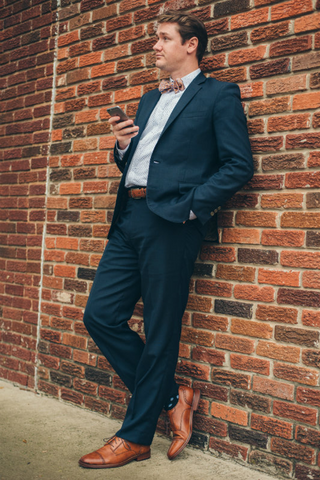 .
. 
We have resources to help you dive deeper into styling the navy suit and gray suit.
We suggest that young professionals stick with suits that are plain or have very subtle patterns for two reasons:
1) It projects maturity to your superiors and colleagues
2) it is easier to mix and match those suits and wear more often.
As for colors, choose two things that complement each other well, like navy and medium gray, that way you can wear the pants of one with the jacket of the other. This can more than double the number of unique looks that you can put together.
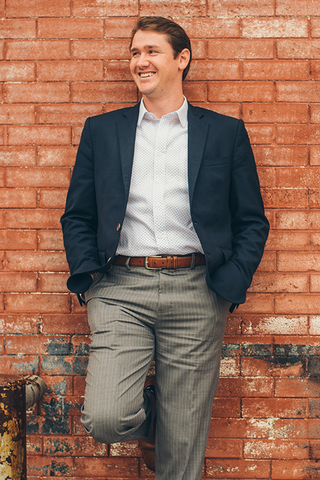 .
. 
Pair the jacket from one with the pants from another to create great, business casual looks.
The fit of this suit will be the most important part of this purchase. You’ll want something that is slimming, not skinny, and the style aspects should stick to the modern standards: notch lapel jacket, no pleats or cuffs for the pants. If you’re buying off-the-rack, be sure to visit a tailor who will make sure the suit fits properly and can make adjustments as needed.
Trying on a suit, but don’t know if it really fits? Check out our blog on fit.
EXTRA PANTS
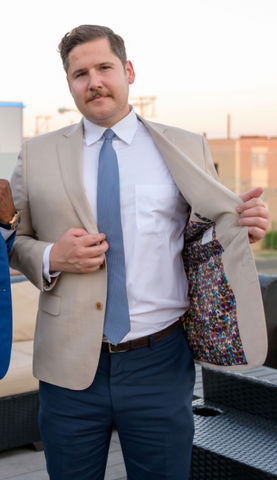 Trousers, slacks, whatever you call them, you’ll need a few extra pairs in your wardrobe. Stay away from the cotton chinos that you’ve “been getting away with” for the last couple years, and go with some fitted, wool slacks in complementary colors to the suits that you own (think: modern blue, khaki/browns, charcoal, or all shades of gray). Also, branch out to some patterns with these pants: a windowpane, a subtle glen plaid or herringbone.
Trousers, slacks, whatever you call them, you’ll need a few extra pairs in your wardrobe. Stay away from the cotton chinos that you’ve “been getting away with” for the last couple years, and go with some fitted, wool slacks in complementary colors to the suits that you own (think: modern blue, khaki/browns, charcoal, or all shades of gray). Also, branch out to some patterns with these pants: a windowpane, a subtle glen plaid or herringbone.
Complete the looks by adding one of your suit jackets, and whenever you need to, a tie. This will be perfect for most days in the office, but if a big client is in town or you’re giving a presentation to the boss, stick with a full suit.
JEANS
Whether you travel occasionally for work or your office just has a great casual Friday policy, a good pair of jeans is going to come in handy.The fit of your jeans is just as important as your suits. Go with a slim-fitting (not skinny), dark denim without all the flair of distressed washes, holes, or decoration on the back pockets and get them hemmed so they are the proper length, it's worth it. Pair it with one of your business shirts or a button-down sport shirt and one of your suit jackets or fun sport coat if you have it.
Prices can vary a lot here. Find what you like and feel comfortable in your price range. Personally, we find great success with Joe’s Jeans which can go for around $100 on sale to about $200 at full price.
SHIRTS
Outside of suits, your shirts are arguably the most important items in your closet and need to be picked the most carefully. The rule of thumb is to stick with lighter colors like white or light blue. If you branch into patterns, lighter colors and subtle. patterns. The darker colors and louder patterns work great for casual days or with just a pair of slacks. Here are the things to look for when picking out shirts:
- Tailored fit: whether you take your shirt to the tailor or buy one that is already fitted, get rid of the “wings” or the “flying squirrel” when you lift your arms.
- Correct Sleeve Length: The sleeve length should fall just over your wrist, but not reach the thumb knuckle
- Conservative Colors and patterns: White, light blue, and occasionally, a light pink or purple. Patterns that are small or that are just textures to the shirt are best.
- Never Wrinkled: Even “non-iron” shirts need to be ironed most of the time. If you can’t iron, learn how or get your shirts dry cleaned.
The fit is what will determine how much you like your shirt, so get some that looks flattering. If you find a particular brand that works well, stick with it. I suggest conservative colors and patterns for your business shirts for the same reasons as your suits: 1) It projects maturity to your superiors and colleagues, and 2) it is easier to mix and match with pants, jackets, and ties.
TIES
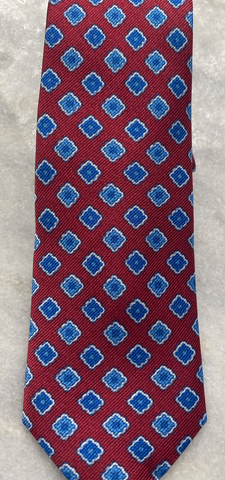 The great thing about ties, is that they are an easy and fairly inexpensive way to make your wardrobe feel bigger. Especially since your suits will be conservatively colored, ties allow you to add a little color and personality to your daily life. Cycle through them, without wearing the same one multiple days in a row, and no one will notice that you are just beginning to build your wardrobe.
The great thing about ties, is that they are an easy and fairly inexpensive way to make your wardrobe feel bigger. Especially since your suits will be conservatively colored, ties allow you to add a little color and personality to your daily life. Cycle through them, without wearing the same one multiple days in a row, and no one will notice that you are just beginning to build your wardrobe.
Start with twice as many ties as you wear on the average week. So, if you wear a tie 2-3 times a week, try to start with 5 ties. If you’re on a budget the most important thing here is to make sure each tie goes with more than one shirt you own. Also, stick to ties 2.5 to 3 inches in width. Too skinny isn’t professional, but too wide won’t be the look you want either. Rule of thumb, your ties should be darker then your shirts.
Did I mention inexpensive? Right now, the skinnier ties that your Dad wore in the 70’s or 80’s are once again popular. Raid his closet and find something in a classic stripe or geometric dots that isn’t too worn out and make it yours. For other inexpensive options, check out online tie stores like The Tie Bar for decent quality ties.
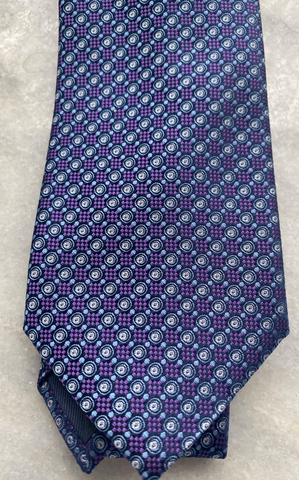
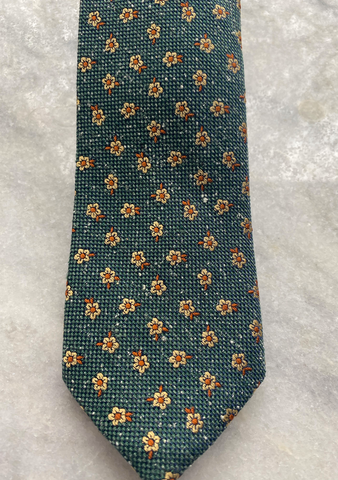
SHOES
The best advice for shoes is not to skimp and buy the least expensive thing you can find. You are going to be spending more time in these things than you are your bed. Think about that. Your feet will thank you for going with a better-quality shoe. I suggest a leather sole as well so that you can re-sole the shoe as many times as you need. Expect to spend about $100-150 on a decent, leather-soled shoe, and don’t forget a belt to match.
One brown pair and one black pair is enough to get you started. If you own or can also get a more casual pair, go with something in a different style like a loafer or something suede that can be worn with jeans, chinos and even slacks on your more casual days. Wear your brown shoes more often than your black ones so when you do have more formal events, the black shoes will be in great condition.
When it comes to styles, choose something that looks classic, and unless you know that you love it avoid the extra intricate designs of brogues. A nice oxford will be a wise choice that will never completely go out of style.
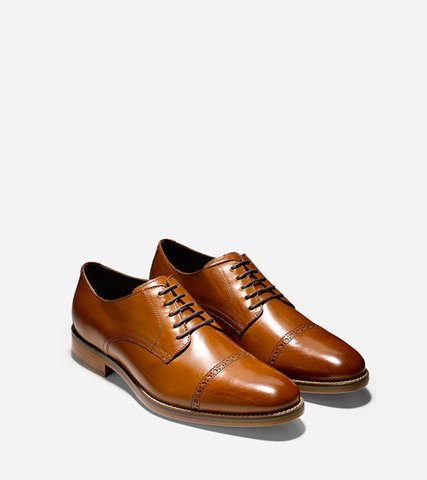

TAKE CARE OF THE THINGS YOU OWN
The last takeaway from this long post is to take good care of the things you do buy and already own, that’s the only real way to build a wardrobe. Extend the life of your business clothes, try to avoid wearing your business attire out on the weekends, unless you’re attending a business event.
You’ll want to dry clean your suits occasionally, but don’t do it excessively, as it can shorten the life of your suit. When its wrinkled or if it gets some bad odors (like smoke from a happy hour bar), let it hang in the open or lightly steam it. Same goes for small little dirty areas, spot clean them if you can.
Learn to launder and iron your own shirts. It will save you money (dry cleaning) and money (buying new shirts when the old ones wear out faster). Yes, that’s money twice.
Wash your jeans sparingly, too, or the color will start to fade. And when you do wash them, do it inside out and always hang dry.
Finally, your shoes, get them buffed and polished a few times a year, whenever they look like they need a little TLC. And don’t forget about getting them re-soled when they start wearing thin or close to the woodwork at the base of the shoe.
